 |
 |
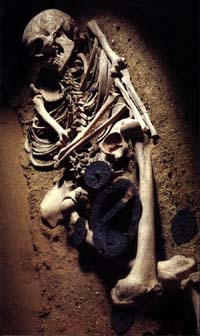 Man's skeleton, 5th to 7th century AD, from the Anglo-Saxon cemetery at Westgarth Gardens. |
Archaeological Collections
ARCHAEOLOGY
Archaeology is the study of people in the past using the evidence they have left behind, from buildings to field systems, from their everyday rubbish to their most precious treasures. In the towns, villages and countryside of West Suffolk, the evidence survives all around us, and at West Stow some of the finest fragments from our remote past are on show.
The First Hunters 400,000 - 8500 BC
The Palaeolithic or Old Stone Age describes the hundreds of thousands of years - over 95% of all human existence - that people lived as roaming hunters. Using stone, flint, antler, bone and wood for their tools and weapons, they followed the seasonal patterns of animal and vegetable life. For much of the period, ice sheets covered our local landscape and life would have been impossible. However, there were warmer spells in the Ice Age lasting 20,000-30,000 years when hunting groups would roam north-westwards from Central Southern Europe across what is now the North Sea and English Channel. At Hoxne, hand axes and flakes have been found dating from one of these warm spells around 350,000-300,000 years ago - the Hoxnian Interglacial.
SEASONAL SETTLERS 8500- 4500 BC
When the glaciers finally retreated around 10,000 BC, a bleak wilderness slowly became covered in forest and people evolved new technologies to deal with their surroundings. The Mesolithic or Middle Stone Age describes this period when hafted axes and 'composite' tools like harpoons and spears made from several tiny razor-sharp microliths appear for the first time. These sophisticated hunters and fishers used fire and axes to make clearings in the forest and developed complex tools and equipment, though rarely does anything other than flint or stone survive.
|
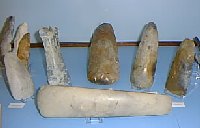 A selection of polished flint axeheads, Neolithic period, c.4500-2000 BC. |
THE FIRST FARMERS 4800 - 2500 BC Sometime after 5000 BC a new economy and new technology including pottery begin to appear. The Neolithic or New Stone Age as it is called features a much more sophisticated toolkit of flint with blades, knives, scrapers and other flake tools, together with leaf-shaped arrowheads. People were now farming: domesticating animals, growing crops. Permanent settlements now appear for the first time, and we can even see trade links emerging. Stone axes made in Cornwall, Wales and Cumbria have been found locally and can be seen in Moyse's Hall. Evidence now appears for the first time to distinguish the "haves" from the "have-nots": high status burial rites must have been for a tiny elite; purely symbolic instruments of power like "mace-heads" were now made and used.
|
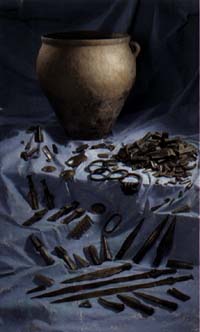 Part of the late Bronze Age Isleham hoard, 10th/9th century BC. |
THE CHIEFTAINS 2500 - 650 BC The Late Neolithic/Early Bronze Age period (2500-1800 BC) was dominated by an influx of newcomers. The 'Beaker People' are so called because of the richly decorated pottery drinking vessels they buried with their dead. These were the first metalworkers - copper and bronze possessions now occasionally appear in such burials. Through the Middle and Later Bronze Age (1800-650 BC), the population continued to grow and lowland landscapes in areas such as the Breckland became more and more ordered as field systems, roads and settlements expanded. Many burial mounds of the rich and powerful - the famous 'Round Barrows' - have been found locally. The men who were buried here often display weapons of war such as bronze swords and spears, as well as axes, together with possessions of great beauty, sometimes in gold or jet. Ritual was now an important feature of life - ritual sites and objects that represent symbols of power were becoming more spectacular. This, after all, was the "Age of Stonehenge".
|
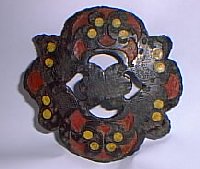 Iron Age enammeled bronze Harness Mount, 1st century AD, from Norton, Suffolk. |
BRITISH TRIBAL KINGDOMS 650 BC - AD 43 During the 7th century BC, iron tools and weapons appear for the first time. Longer, sharper and stronger, these were the weapons of the military aristocracy with the wealth and power to control vast regional populations and to define and defend political boundaries. We learn from Roman historians of the rivalries and alliances which dominated the region in the 1st century BC. The Trinovantes tribe had been conquered by the Catuvellauni in Southern Suffolk. Meanwhile, across the impenetrable forests of the central claylands, the Iceni held sway to the North. Whatever their political or feudal loyalties, ordinary people lived and worked in farmsteads and fields, farming the land as their ancestors had done for centuries.
|
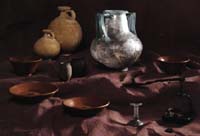 Grave goods from the 2nd century Roman tumulus burial at Rougham. |
OUTPOST OF AN EMPIRE AD 43 - 410 The Roman Occupation saw the introduction of many alien features into local life and landscape: magnificent military roads and forts; towns; villas with mosaic floors, central heating and painted plaster walls; money; written records and laws; mass-produced pottery from great factories in Britain and abroad; luxuries and other goods from across the Empire; new religious practices, including Christianity. Whilst the Boudiccan revolt of AD 61 left the Roman capital at Colchester in flames, its brutal defeat was eventually followed by a peaceful provincial life for three centuries. With manufactured goods now available in all manner of materials, enough has survived to help us understand everyday life in some detail.
|
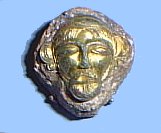 Viking lead weight decorated with a gilt bronze face.
|
THE EASTERN ANGLES 410 - 1066 As the rule of Rome in Britain finally collapsed in the early 5th century, Anglian settlers from around Holland and the Jutland Peninsula migrated into the region, bringing with them a new culture. Beliefs, language, art, the economy, all developed and adapted once more. Here at West Stow, 7 miles from Bury St Edmunds, an Anglo-Saxon village of this period has been excavated and reconstructed; today one can walk amongst those buildings as they may have looked 1500 years ago, while at the galleries on site some of the thousands of finds from the village and nearby cemetery are displayed. Christianity was re-introduced into England and from the 7th century onward it spread rapidly. A monastery was founded at Bedricesworth, then just a small settlement in West Suffolk. So it might have remained but for a crucial accident of history. In 869 Edmund, King of the East Angles, was killed fighting the Danes at the battle of Haeglisdun (probably Hellesden, Bradfield St Clare). Edmund became a martyr of the Christian faith; for many years, until the 14th century, the patron saint of England. His remains were brought to the abbey at Bedricesworth; Bedricesworth became Bury St Edmunds,the 'burh' or town of St Edmund,a centre of pilgrimage throughout the medieval period. The pilgrims brought immense wealth and importance to the abbey and town alike. Bury St Edmunds was on its way. Today this story is told at Moyse's Hall. Many finds from the abbey and objects which reflect the symbolic significance of the Edmund tradition for Bury St Edmunds can be seen in Moyse's hall Museum, where the story of the past continues after 1066.
|
| Period | Date | Characteristics | Collections at West Stow |
|---|---|---|---|
| STONE AGE (Paleolithic, Mesolithic and Neolithic). | before - 2500 BC | Hunting, fishing, food-gathering, later some farming. | Flint tools, stone axes, antler picks and antler mace-head. |
| BRONZE AGE | 2500 - 700 BC | First use of metal tools. | Beakers, arrowheads, axe-heads, urns, leather-making tools, weapons, jet necklace and Isleham Hoard. |
| IRON AGE | 700 BC - AD43 | First use of iron tools | Vessels, coins, terret rings, spearheads and pottery. |
| ROMAN | AD43 - 410 | Development of roads and towns, monetary economy with mass-production and overeseas trade. Introduction of Christianity. | Fragments from villas, coin hoard, objects from Rougham tumulus and Haverhill casket burials, pottery and household objects. |
| ANGLO-SAXON | AD43 - 1066 | Pagan settlers with rural moneyless economy. Later, Christianity and learning reintroduced. Towns, trade and monetary system arise again. | Grave goods from West Stow and Westgarth Gardens cemetery and objects from West Stow Anglo-Saxon Village. |
| Go to Museums homepage | Go to Anglo-Saxons homepage |
This page originally produced by Museum staff for the Council's website 2002 Updated 16 August 2009 | Go to Home Page |